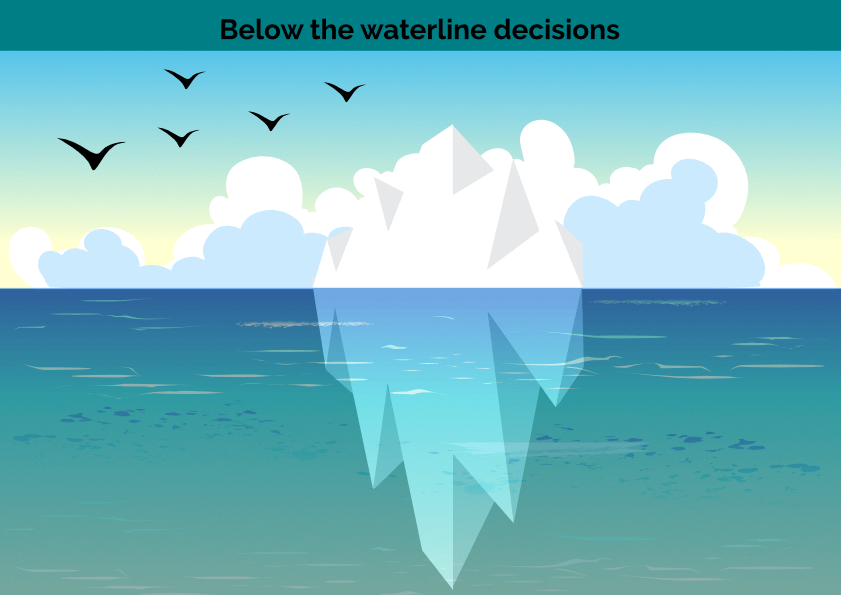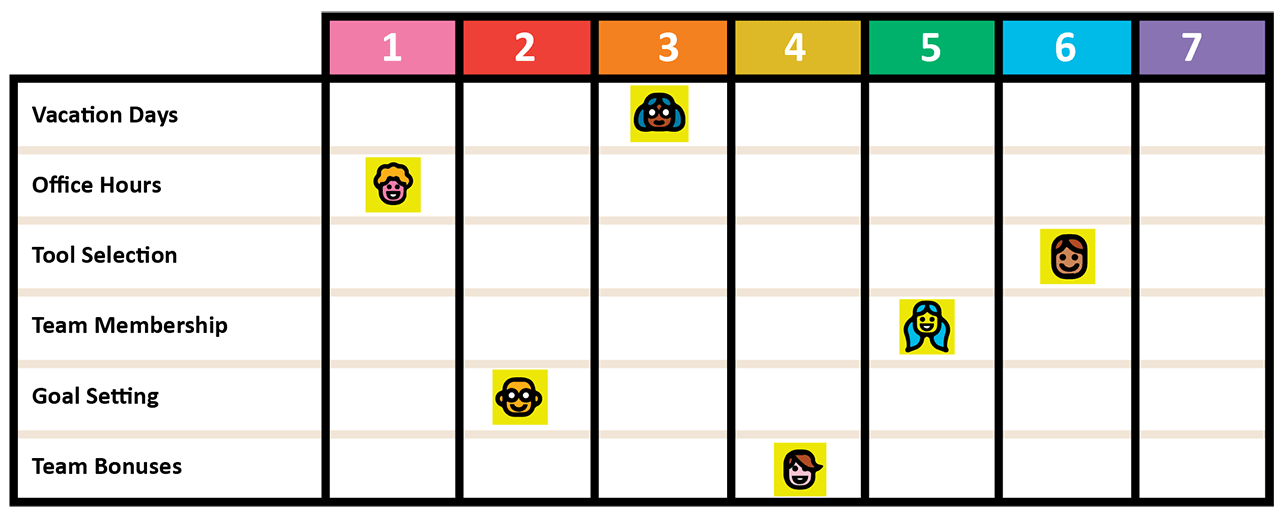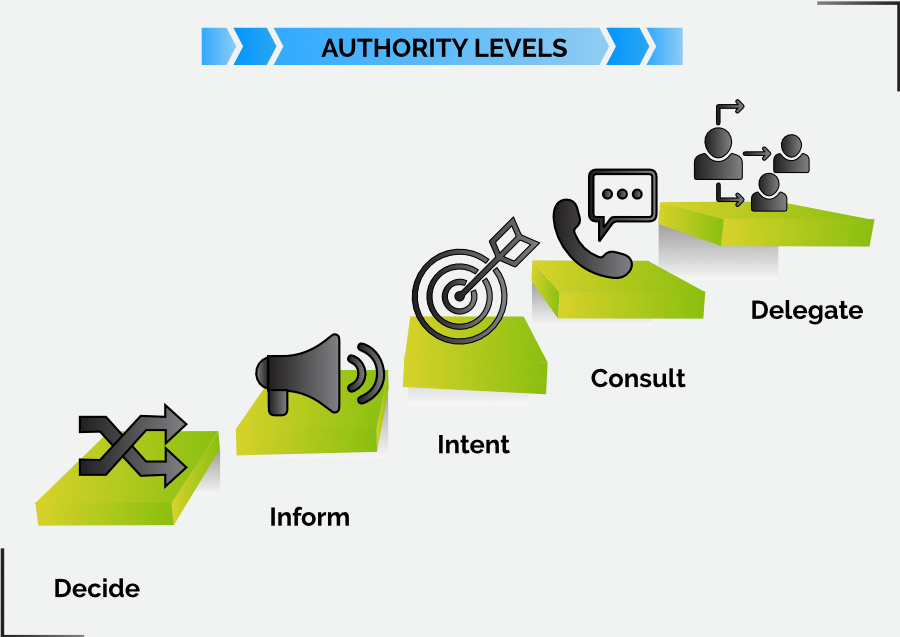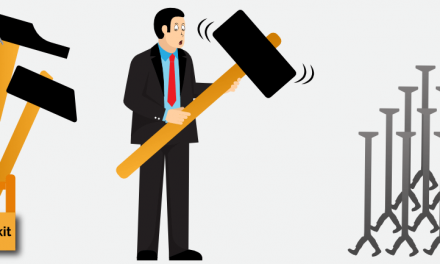This is part 2 of a two part article on empowerment. In the previous article we covered the reasons for empowerment; building the right environment for empowerment based on engagement, purpose, and values; and some important principles.
In this part we will cover practical tools to get you started with empowerment en delegating.
This article is part of a series
[series_post_list_box]
What can you expect from this two-part article?
- Understand why empowerment is important
- The principles behind successful empowerment
- Simple yet powerful tools to start implementing empowerment in your organization
Decentralize as far as responsible
Although you will probably want to start at a pace both employees and managers can absorb, the final result should be to decentralize as far as responsible. And even that is a moving target. We could say ‘as far as possible’ but there will always be matters you do not want to delegate and that is fine. However, as individuals and teams get more nature in taking on responsibility, the limit of what is respopnsible can be pushed further down.
Reverse Delegation
My gut feeling is that what I call radical decentralization goes further than most companies dare or are willing to go that are currently experimenting with empowerment, delegaton, distribution of authoruty and so on. But if you do follow me wonderful things in terms of engagement and resileince of your company can be the result.
We could call this reverse delegation: all authority lies in the hands of the employees, except for what they wish to delegate upwards, and what is explicitly set as out of scope. This may sound radical but think about it for a minute: regular delegation means that managers only delegate what they wish to delegate. Traversing down the hierarchical chain this could seriously dilute the amount of delegation to a point it is just paying lip service to the concept.
Below the waterline decisions
A concept adopted by Gore, the makers of Gore-tex is that of Below the waterline decisions1, meaning decisions that can sink the boat. Every other decision can be taken by any employee, but for below the waterline decisions, that can seriously harm the company, you are required to council a leader who might be better informed.
This is a very simple rule of authority but for most companies it would take a while to get there.

Levels of Delegation
Note that with reverse delegation you can reduce the levels of authority in the company hierarchy a lot. You wouldn’t even need one in the end. But for most organizations that will not be an accepted way to start. So we need a tool that helps us with delegating decision-making which potentially leaves the hierarchy itself intact.
Seven levels of delegation
Delegation is not a on/off switch. It is not binary. It is much more subtle. There are multiple levels of delegation and which level is appropriate can widely vary per decision area. Management 3.0 defines seven levels2. The levels are:

1 Tell
You as a manager decide and you inform others of the decision made. This is obviously the lowest level of delegation. Actually, this is not delegation at all, but there will be areas where you just cannot delegate decision making.
2 Sell
You decide but you do try to convince others it is the right decision.
3 Consult
You ask for input, and then make a decision taking the input into account.
4 Agree
You try to reach consensus as a group on the right decision.
5 Advise
You offer your opinion but it is their decision to make.
6 Inquire
They make the decision but you do want to be informed. You also want the decision maker to try to convince you it is the right decision.
7 Delegate
They make the decision and you don’t even have to know what it is.
How does it work?
The first step is to identify areas of decision making. Be as specific as possible. Don’t do this on your own, do it together with the people you are delegating decisions to. It is ok to prepare a preliminary list but don’t fall into the trap of unconsciously choosing the lowest level of delegation for… implementing delegation.
The second step is to go by each decision area and agree on the appropriate delegation level. It is ok to be clear that some topics will have a lower level of delegation for now, after all you are setting constraints. People understand you won’t be leaving everything up to them. Don’t forget the reflexive principle: team members might not feel comfortable with a high delegation level at some areas, even if you feel confident they can do it.
Management 3.0 has nice sets of cards available that represent the delegation levels. You can use these just to make things more visual: it has more impact to point to a card than to say ‘level 4’. You can also use the cards to play Delegation Poker, a derivative of the Agile estimation technique Planning Poker.
Delegation Board
The Delegation Board is the final step: it is the visual result of the agreements made. The Delegation Board is a grid that displays all decision areas as rows and the 7 delegation levels as columns. It marks the delegation level for each decision area. Being transparent on the agreed delegation levels is crucial.

An example of the use of the delegation board is a manager who had two goals: the first was to increase the level of responsibility of the team leaders in her group. The second one was a very practical one: to reduce her workload caused by the company policies requiring her to approve everything. She was involved in a lot of processes and decisions of which she felt her added value was limited. The team leaders could very well decide themselves.
You can use the delegation levels the other way around as well. The same manager was in a new role. The boundaries of her authority were blurred. She sometimes felt a lack of authority in areas she would have expected otherwise. The organization still needed to get used to the new role. In such a situation you can also use the delegation levels to clarify constraints upwards: discuss delegation levels on key decision areas with your manager.
Ladder of authority
The seven levels do work top-down from the manager towards employee. Otherwise, tell and delegate are exactly the same, as are sell and inquire, and consult and agree. So, the seven delegation levels only make sense if the hierarchal relation still exists after delegation of authority. This makes the delegation levels a very useful tool when an organization starts with empowerment but is not ready yet to abandon most of the hierarchal structure. It is somewhat less usable in situations where most of the hierarchal structure is abandoned or to be abandoned, or when teams of peers want to make agreements on decision-making.
For these situation the five levels of authority we have defined in our own research might be more appropriate. These levels are:

Decide
One person can make the decision. No need to inform anyone.
Inform
One person can make the decision but he is required to inform those who are effected or involved.
Intent
One person expresses his intent towards those that will be effected, or, others can ask what someone intents to do. This way (unsolicited) advise can be offered, before a decision is made.
Consult
One person can only make a decision after consulting those that will be effected by the decision, and after he has demonstrated how the the advise has influenced the decision to be made.
Delegate
The decision in this area has been delegated to one specific person (or institution) which may or may not be a higher hierarchal level.
How to use the Ladder of Authority
The way to use the five levels of authority resembles the levels of delegation a lot. Again the appropriate level differs per decision area. So you start with defining decision areas and next you collectively decide on the right level per area. You can use a board to visualize the result just like the delegation board.
Note that the Ladder of Authority assumes the situation of Reverse Delegation. It starts with the notion that employees can decide anything and then we collectively put constraints on that notion using the five levels.
Also note that Intent is the sweet spot level in the model. It is a little more constraining than Inform and a little less than Consult. It is a very natural way of conversation: you express what your intention is which allows the other to respond. It also stimulates dialog.
Be aware of the difference between the level delegate here and in the levels of delegation. They can even be eachothers opposite. But remember that in the ladder of authority it is the employees who might decide to delegate something to a manager.
Conclusion
Empowerment is important to improve the speed and quality of decisions. It is also hard to implement. First you need to understand that removing part of the chain of command needs something to replace it with: engagement, purpose, and values. And if you then get to the actual delegating there as some important principles to watch out for.
We covered simple tools to aid in empowerment. Although these tools are easy to use, empowerment is far from easy to implement. The seven delegation levels are most useful when a hierarchal relationship between manager and employees still exists after delegating. The ladder of authority is more useful when you want to abondon most of the hierarchy or in a situation among peers.
Bibliography
List of notes and sources we reference from.
Notes
- Carney, Brian M. and Getz, Isaac. (2009). Freedom Inc. Domme Valley House. Page 10.
- https://management30.com/practice/delegation-poker/
Follow this article
You can choose to follow this article in which case you will be notified when there there are updates of the article. You can also choose to follow all articles of this category. You will then be notified if a new article is added in this category.





